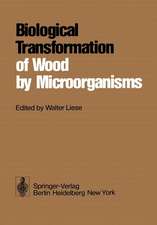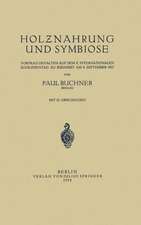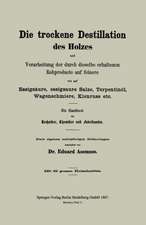Wood is Good: Current Trends and Future Prospects in Wood Utilization
Editat de Krishna K. Pandey, V. Ramakantha, Shakti S. Chauhan, A.N. Arun Kumaren Limba Engleză Paperback – 3 mai 2018
| Toate formatele și edițiile | Preț | Express |
|---|---|---|
| Paperback (1) | 1825.27 lei 6-8 săpt. | |
| Springer Nature Singapore – 3 mai 2018 | 1825.27 lei 6-8 săpt. | |
| Hardback (1) | 1831.42 lei 6-8 săpt. | |
| Springer Nature Singapore – 3 feb 2017 | 1831.42 lei 6-8 săpt. |
Preț: 1825.27 lei
Preț vechi: 2225.94 lei
-18% Nou
Puncte Express: 2738
Preț estimativ în valută:
349.31€ • 379.30$ • 293.42£
349.31€ • 379.30$ • 293.42£
Carte tipărită la comandă
Livrare economică 22 aprilie-06 mai
Preluare comenzi: 021 569.72.76
Specificații
ISBN-13: 9789811097942
ISBN-10: 9811097941
Ilustrații: XIV, 480 p. 126 illus.
Dimensiuni: 155 x 235 mm
Greutate: 0.69 kg
Ediția:Softcover reprint of the original 1st ed. 2017
Editura: Springer Nature Singapore
Colecția Springer
Locul publicării:Singapore, Singapore
ISBN-10: 9811097941
Ilustrații: XIV, 480 p. 126 illus.
Dimensiuni: 155 x 235 mm
Greutate: 0.69 kg
Ediția:Softcover reprint of the original 1st ed. 2017
Editura: Springer Nature Singapore
Colecția Springer
Locul publicării:Singapore, Singapore
Cuprins
Section A: Wood Properties and Variability_Chapter 1. Optimizing Wood Utilization Based on Whole Tree Inherent Property Maps.- Chapter 2. Screening Corewood of Pine for Wood Properties.- Chapter 3. Imaging Spiral Grain in Pinus radiata with X-ray Microtomography.- Chapter 4. Rapid Assessment of Wood Density in Standing Trees of Acacia Mangium Willd. Using Resistograph – A Nondestructive Method.- Chapter 5. Eliminating Growth-Stresses in Eucalyptus: A Scoping Study with E. bosistoana and E. nitens.- Chapter 6. Longitudinal Growth Strains in Melia Dubia.- Chapter 7. Immunofluorescence Localization of β-(1-4)-D-galactan, and Xylans in Tension Wood and Normal Wood Fibres of Leucaena Leucocephala.- Chapter 8. Comparative Wood Anatomy of Four Artocarpus Species of North East India with Reference to their Identification.- Chapter 9. Wood anatomy of Some Members of Family Fagaceae from North East India.- Chapter 10. Anatomical Characterization and In vitro Laboratory Decay Test of Different Woods Decayed by Xylaria Hypoxylon.- Chapter 11. Growth Ring Structure and Specific Gravity Variation in Juvenile and Mature Wood of Natural-grown Teak (Tectona grandis L. f.).- Chapter 12. Variability for Heartwood Content in Three Commercially Important Tree Species of Peninsular India – Hardwickia Binata, Pterocarpus Santalinus and Santalum Album.- Chapter 13. Relations between Growth Traits and Wood Parameters of Tectona grandis L.f in Even-aged Plantations in Tamil Nadu.- Chapter 14. Variation in Heartwood Formation and Wood Density in Plantation Grown Red Sanders (Pterocarpus Santalinus).- Chapter 15. Identification and Characterization of Tension Wood in Acacia Auriculiformis A. Cunn. Ex Benth and Acacia Mangium Willd. Grown in Kerala.- Chapter 16. Basic Density and Fibre Morphological Characteristics of Selected Pulpwood Species of Kerala.- Chapter 17. Estimation of Leaf Area–wood Density Traits Relationship in Tropical Dry Evergreen Forests of Southern Coromandel Coast, Peninsular India.- Chapter 18. Variations on Pulping Properties of Gmelina Arborea Roxb. Grown in Different Geographical Regions of Tamil Nadu, India.- Chapter 19. Biochemical Characterization of Wood Lignin of Hevea Brasiliensis.- Section B: Wood Protection_Chapter 20. Protection of Wood: A Global Perspective on the Future.- Chapter 21. Conveyor Belt Pressure Impregnation of Wood.- Chapter 22. Natural Resistance of Imported Timbers against Termites and Fungi in Indian Condition – A Comparison.- Chapter 23. Enhancing Photostability of Wood Coatings Using Titanium Dioxide Nanoparticles.- Chapter 24. Screening of Oils of Pongamia Pinnata Linn., Jatropha Curcus Linn. and Simarouba Glauca. D.C. for Developing Eco-friendly Wood Preservatives.- Chapter 25. Fungal Inhibition in Wood Treated with Lantana Camara L. Extract.- Chapter 26. Powder Post Beetle Menace in Wooden Handicraft Industries and their Management.- Chapter 27. Effect of Thermal Modification on Physical Properties of Bambusa Nutans.- Section C: Wood-based Composites_Chapter 28. Micromechanics of Cellulose Fibers and their Composites.- Chapter 29. Adhesives of Bio Origin for Wood Composites.- Chapter 30. Experimental and Numerical Modeling of Hemp Polyester Composites.- Chapter 31. Lantana Fiber Filled Polypropylene Composite.- Chapter 32. Development of Fire Retardant Wood Composite Using Amino Resin.- Chapter 33. Study on Utilization of Plantation Grown Timber Species Grevillea Robusta (Silver Oak) for Medium Density Fibre Board.- Chapter 34. Suitability of Mixed Species of Bamboo (Bambusa Polymorpha and BambusaTulda) for Medium Density Particle Board.- Section D: Wood Utilization Pattern_Chapter 35. A Comparative Assessment of Autoclave and Microwave Assisted Peroxometal Complex in Delignification of Wood Biomass for Enhanced Sugar Production.- Chapter 36. Yield Evaluation of Oyster Mushroom on Dust Waste of Some Common Timber Species.- Chapter 37. Study on Fuel Properties of Important Biomass Briquetting Feedstocks in India.- Chapter 38. Study on Chemical, Elemental and Gasification Characteristics of Lantana Camara Wood.- Chapter 39. Search for Future Fuels – Pathway Points to a ‘Boring’ Process.- Chapter 40. Wood Use in India – Readying for that Elusive Renaissance?.- Section E: Wood and Climate Change_Chapter 41. Wood is Good for REDD+!.- Chapter 42. How Good is Wood? Facts and Myths Regarding Wood as a Green Building Material.- Chapter 43. Carbon Sequestration by Bamboo Farming on Marginal Land and Sustainable use of Wood Waste for Bioenergy: Case Studies from Abellon Clean Energy.- Chapter 44. Use Wood – Combat Climate Change.
Notă biografică
Dr. Krishna K. Pandey is a senior scientist at the Institute of Wood Science and Technology, Bengaluru, having more than 30 years of research experience. He was Postdoctoral Researcher, Kyoto Institute of Technology, Japan; Senior Researcher at Helsinki University of Technology, Finland. Dr. Pandey has published more than 50 papers in peer reviewed journals. He is an elected Fellow of International Academy of Wood Science and a recipient of National Award for Excellence in Forestry Research by the Indian Council of Forestry Research and Education, Government of India. Presently, he is a member of Environmental Effects Assessment Panel of UNEP.
Dr. V. Ramakantha was the Director of the Institute of Wood Science and Technology, Government of India and he retired as Principal Chief Conservator of Forests, Manipur, India. He is well known in the fields of Forestry Research and Education, Wildlife Conservation and Ex-situ Conservation of flora and fauna. As a prolific writer, he is an author for two books, and has published several articles in peer reviewed journals and magazines. He was the Chairman of the Committee on National Strategy and Working Scheme for the Management of Red Sanders (Pterocarpus santalinus). Dr. Ramakantha is a Fellow of the Society for Applied Biotechnology and a Guest Faculty in several reputed institutions in India. He has received international recognition in the field of wildlife photography.
Dr. Shakti S. Chauhan is a senior scientist at the Institute of Wood Science and Technology, Bengaluru with more than 20 years of research experience. He was a Ph.D. Scholar, Postdoctoral Researcher and FAO Fellow at University of Canterbury, Christchurch, New Zealand. Dr. Chauhan is recognised internationally for his work on Wood Quality Assessment and Wood Polymer Composites. He has published more than 50 papers in peer reviewed journals and co-authored two books on wood science. He is a reviewer for several international journals in the field of Wood and Material Science. He is a Member, Committee for Timber Storage, Bureau of Indian Standards. Dr. Chauhan received Appreciation Award for his contribution in the field of Wood Technology, conferred by the Honourable Governor of Karnataka.
Dr. A. N. Arun Kumar is a senior scientist of the Institute of Wood Science and Technology, Bengaluru. Having research experience of more than two decades, he has published several articles in peer reviewed international journals and has also been a reviewer for many high impact journals on forestry. Dr. Arun has carried out pioneering research work on heartwood and oil variation in the Indian Sandalwood (Santalum album), the most valued tree species of India. His extensive research on growth and wood quality variability of several commercially important tree species like Pterocarpus santalinus, Chloroxylon swietenia, Hardwickia binata, Melia dubia etc. is a significant contribution in the field of tree improvement.
Dr. V. Ramakantha was the Director of the Institute of Wood Science and Technology, Government of India and he retired as Principal Chief Conservator of Forests, Manipur, India. He is well known in the fields of Forestry Research and Education, Wildlife Conservation and Ex-situ Conservation of flora and fauna. As a prolific writer, he is an author for two books, and has published several articles in peer reviewed journals and magazines. He was the Chairman of the Committee on National Strategy and Working Scheme for the Management of Red Sanders (Pterocarpus santalinus). Dr. Ramakantha is a Fellow of the Society for Applied Biotechnology and a Guest Faculty in several reputed institutions in India. He has received international recognition in the field of wildlife photography.
Dr. Shakti S. Chauhan is a senior scientist at the Institute of Wood Science and Technology, Bengaluru with more than 20 years of research experience. He was a Ph.D. Scholar, Postdoctoral Researcher and FAO Fellow at University of Canterbury, Christchurch, New Zealand. Dr. Chauhan is recognised internationally for his work on Wood Quality Assessment and Wood Polymer Composites. He has published more than 50 papers in peer reviewed journals and co-authored two books on wood science. He is a reviewer for several international journals in the field of Wood and Material Science. He is a Member, Committee for Timber Storage, Bureau of Indian Standards. Dr. Chauhan received Appreciation Award for his contribution in the field of Wood Technology, conferred by the Honourable Governor of Karnataka.
Dr. A. N. Arun Kumar is a senior scientist of the Institute of Wood Science and Technology, Bengaluru. Having research experience of more than two decades, he has published several articles in peer reviewed international journals and has also been a reviewer for many high impact journals on forestry. Dr. Arun has carried out pioneering research work on heartwood and oil variation in the Indian Sandalwood (Santalum album), the most valued tree species of India. His extensive research on growth and wood quality variability of several commercially important tree species like Pterocarpus santalinus, Chloroxylon swietenia, Hardwickia binata, Melia dubia etc. is a significant contribution in the field of tree improvement.
Textul de pe ultima copertă
This book is a compilation of selected papers presented in the International Conference on the theme ‘Wood is Good: Current Trends and Future Prospects in Wood’. The contents of the book deal with recent innovations, trends and challenges in wood science and are grouped in five distinct sections. They cover a wide range of topics like wood variability, processing and utilization, wood protection, wood-based composites, wood energy and the role of wood in mitigating climate change. With the ever increasing human population and growing demand for wood, this book offers valuable insights for better understanding and efficient utilization of this wonderful gift of nature. This book will be useful to researchers, professionals, and policy makers involved in forestry and wood related areas.
Caracteristici
Covers wide range of topics in Wood science ranging from wood variability and quality issues, processing aspects, wood based composites, chemicals and energy aspects
First of its kind book from Indian authors in this field
Comprises contribution from authors across globe
Includes supplementary material: sn.pub/extras
First of its kind book from Indian authors in this field
Comprises contribution from authors across globe
Includes supplementary material: sn.pub/extras











